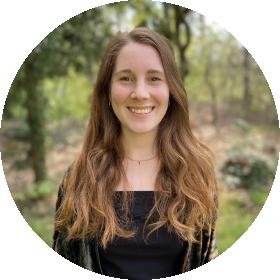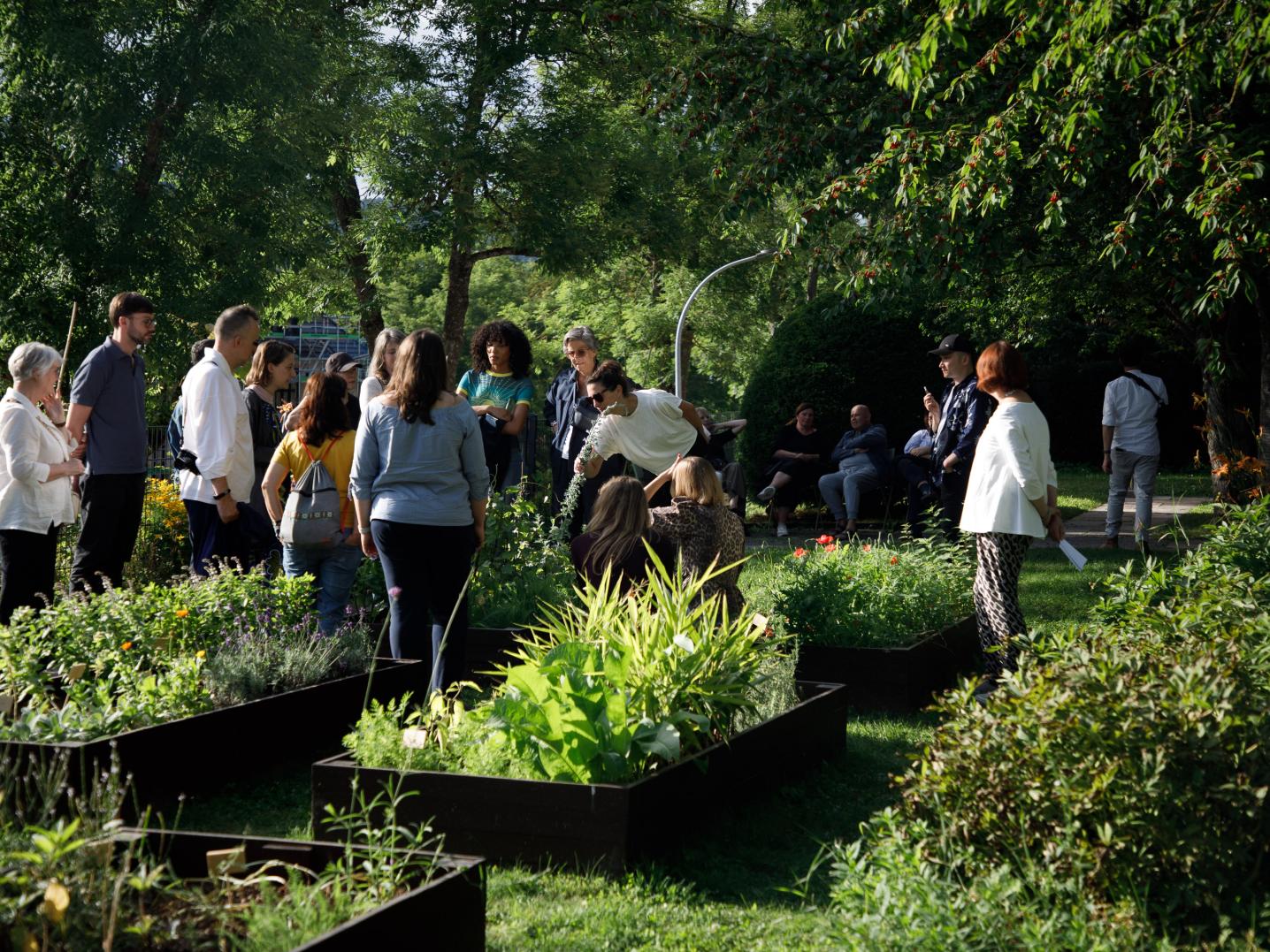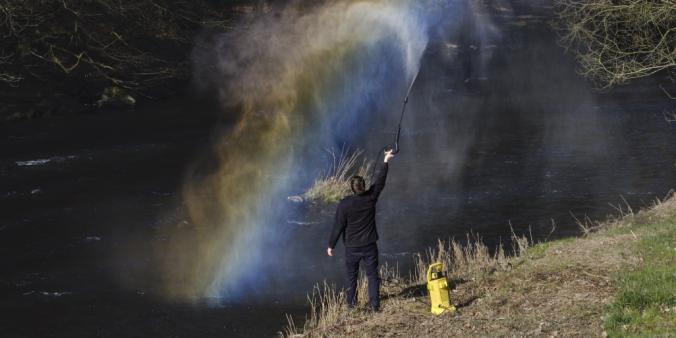
This is the last part of the article series ‘Ab in den Süden’, in which we investigate the opportunities and challenges that come with working in Southern Germany. For this final instalment, we asked seven Netherlands-based cultural professionals to reflect on their visit of Ornamenta 2024, taking place in Pforzheim, Germany.
Last July, DutchCulture and Ornamenta invited seven Netherlands-based cultural professionals to the opening weekend of Ornamenta 2024, a cultural programme for contemporary art and design. We organised a giveaway to offer professionals with varying backgrounds, disciplines and interests the opportunity to experience international cultural collaboration first-hand. And so, Bruno Alves de Almeida, Cleo Tsw, Eva van der Zand, Floor van Spaendonck, Guus Beumer, Mateusz Tkaczen and Tina Lenz not only visited Pforzheim, they also wrote short think-pieces to reflect on this unique experience. To now provide you with personal insights on international cultural collaboration, you can read all about their encounters below.
1. Pforzheim and the Northern Black Forest Region
Germany’s Northern Black Forest region is known for its dense woodlands, curvy hills, deep valleys and dazzling waters, such as the Nagold and Enz. Right where these two rivers meet lies Pforzheim. The city has a rich history, ranging from being an important Roman settlement to its longstanding importance in the jewellery and watchmaking industries. “Pforzheim is perpetually dissolving and reinventing itself,” says Mateusz Tkaczen (maker and architect). “It is built upon its past, upon its rubble. It is reborn and restored, diversified and fluid. The city elongates and overlaps – it responds to the predominant landscape.”
After being heavily bombed during World War II, the city was largely rebuilt. Its modern architecture is reflective of the different industries present. Tkaczen: “It’s an ensemble of manifold structures: water towers, churches, stations, podia, workshops, vitrines, parks and festivals. Open and decentralized, evoking different meanings and interactions, the city is a tableau of platonic relationships rejecting resolution.” Exactly these relationships are what the region a suitable place to organize a cultural programme. Tina Lenz, a design anthropologist, puts it like this: “Ornamenta 2024 demonstrates how design, architecture, and craftsmanship, free from the confines of traditional galleries, can draw contemporary inspiration from German heritage. Through the exchange of knowledge and imagination between (inter)national artists and local communities, the Black Forest becomes a vibrant canvas for innovative cultural expression.”
2. Cultural collaborations and regionality
A key concept in Ornamenta’s cultural programming is the pairing of contemporary artists with local businesses, sites and rural spaces to honour regional traditions, and serve as a model to strengthen and reimagine relationships. “By moving around and settling down in smaller, off-the-beaten-path towns and lesser-known cultural venues, artists can develop deeper relationships within new sites, instead of relying on existing connections in large cities,” says Lenz. Following these notions, director of Bureau Europa Floor van Spaendonck mentions the Binding Chapel as a project that stood out to her. Here, traditional wedding elements are reinterpreted to celebrate any type of relationship – not just romantic ones. She says: “The chapel with the commitments made a great start to the day as the installation symbolised the spirit of the times (away with the pigeonholes), the need for connections, the focus on the role of nature and the relationship with the old Ornamenta as the jewellery industry was given a role in the installation.”
Bruno Alves de Almeida (curator at the Jan van Eyck Academie) and Guus Beumer (freelance curator) reflect on the possible impact of cultural programmes on the region. Alves de Almeida explored Ornamenta’s seasonal and regionally spread character as a catalyst for a more inclusive and interconnected cultural landscape. In doing so, he directly addresses the artists: “While industry partnerships can provide essential resources and broader outreach, it is crucial for artists to navigate these relationships without compromising their creative integrity or critical stance. Maintaining this balance is essential to ensure that art remains a powerful tool for questioning and transforming societal norms, rather than merely serving as a decorative addition to the status quo.” Beumer adds that by having artists and businesses collaborate, Ornamenta visitors and Black Forest entrepreneurs have created a unique financing structure that directly supports the region.

3. Personal encounters
Since this was a trip for learning and networking, we also encouraged the participants to write about their personal encounters. Writer, publisher & assistant coordinator Graphic Design at the Gerrit Rietveld Academie Cleo Tsw, for example, spent her evenings at Café Roland. She quickly figured out this was the spot where local students from the Pforzheim Goldsmith and Watchmaking School hang out. Tsw met a young artist who had studied goldsmithing. While passionate about her craft and jewellery, the artist expressed a desire to broaden her creative vision and move beyond traditional techniques and conventions. This left Tsw wondering how ‘traditional’ could be a synonym for many other things.
Eva van der Zand, a cultural entrepreneur and maker, was particularly interested in learning from other makers who collaborate in duos, as she often works closely with her partner: “Since, I’m working often as a duo with my partner as well, I’m eager to learn from how other makers make decisions who collaborate intensively as a duo." This curiosity led her to Shelving Seasons, an installation by Suzanne Bernhardt and Philipp Kohlmann where the iconic Black Forest cake is reintroduced as a cocktail, made from locally sourced, often overlooked ingredients like cherry pits. The drink is offered to visitors in a series of twenty-minute tasting events. “It’s like they offered me some tasty liquid paint. This colour feels alive, the rich, deep red hue, maroon colour fills the jewellery shop. Deciding as a visitor to take a sip, we become part of their work and their research,” Van der Zand describes her encounter.
After meeting the artists, Van der Zand was inspired by their stories about traditional Black Forest industries and its food customs. It left her with a sense of the complexities involved in merging art, regionality and ecological knowledge: “Bernhardt uses edible storytelling to address our relationship with to the land we inhabit. By delving into the historical and geographical roots of food, she unveils the stories behind what nourishes us. Kohlmann delves into the realms of food, microbes, smells, and taste to craft multifaceted experiences that reconnect us with the ground we stand on. I for sure experienced they both developed a unique skill of delving into complexities. And I realize one of the hard parts is how to summarize the depth of their research and decisions for an audience that comes in for 20 minutes and leaves again.”

Conclusion
So, what can we learn from the experiences described above? What should professionals and (policy) makers take into account when considering working in Southern Germany or another lesser known German region?
• Blend local traditions and heritage with contemporary values and practices;
• Develop policies and financial structures that facilitate collaborations between artists and local businesses;
• Make sure that artists retain creative autonomy when collaborating with different industries;
• Embrace decentralisation and shift to a more regional focus;
• Encourage personal encounters and local experiences to broaden your artistic and/or professional scope.
With contributions by:
Bruno Alves de Almeida: curator at the Jan van Eyck Academie, Maastricht / artistic director at Luleå Biennial 2024
Cleo Tsw: writer, publisher & assistant coordinator Graphic Design at the Gerrit Rietveld Academie
Eva van der Zand: cultural entrepreneur / maker
Floor van Spaendonck: director of Bureau Europa
Guus Beumer: freelance curator
Mateusz Tkaczen: maker / architect
Tina Lenz: design anthropologist





